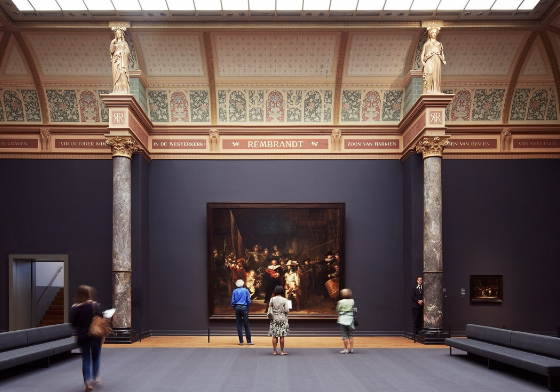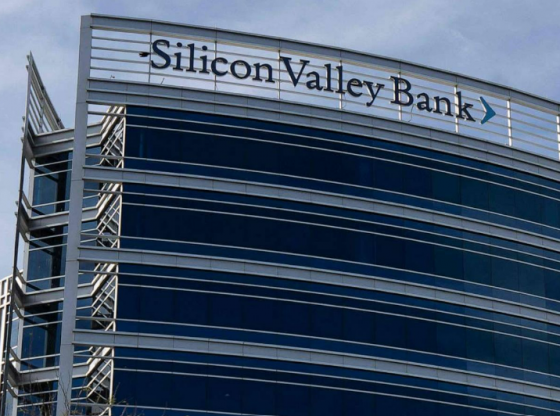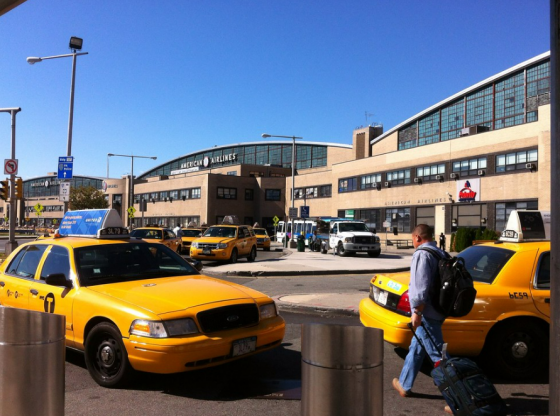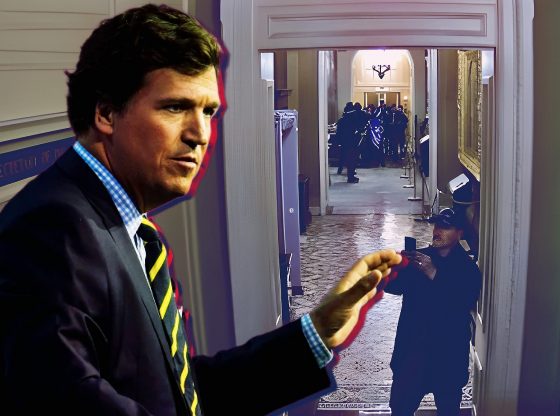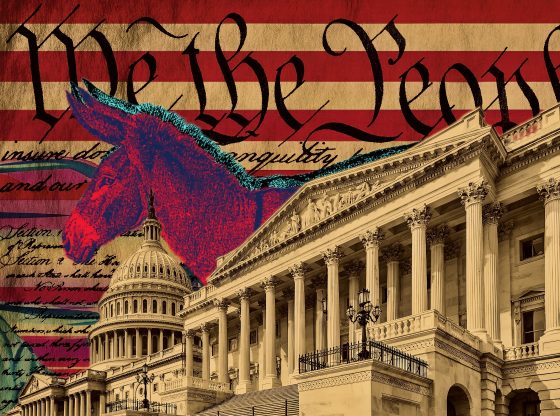Music, art, food, and beautiful scenery.
When New York City’s crime and grime get you down, it’s a breeze to leave. So, I did.
Newark Airport, one of Gotham’s three airborne escape routes, took me to Amsterdam for the weekend.
Trains into town are a snap: They depart every 5–10 minutes from tracks immediately below Schiphol Airport’s arrival terminal. The €5.90 ($6.30) ride reaches Amsterdam Centraal Station in just 13 minutes. Few air-rail connections top this one.
An eight-minute roll, with luggage, took me from the front door of Centraal Station to Swissotel at Damrak 96, on the main draag that extends southwest of the train terminal. Its location is perfect. These modern accommodations are across from de Bijenkorf, a huge department store — the Dutch Saks Fifth Avenue. Just a 25-second walk from Swissotel’s front door sits Dam Square, Amsterdam’s largest. Its key attractions are the luxurious Grand Hotel Krasnapolsky, large alfresco restaurants, and the Dutch Royal Palace.
I checked into Room 615, a spacious suite with a king bed, wide desk, cozy sofa, spacious bathroom, deep tub, shower stall, towel heater, and spectacular view of Dam Square. What a comfortable base for a scenic, relaxing stay.
Swissotel’s Royal98 restaurant’s hearty breakfast went well beyond coffee and croissants. Atop hot drinks and chilled, fresh-squeezed orange juice, it offered multiple cheeses, sliced meats, scrambled eggs, sausage, and crispy, brittle, heavenly bacon. This spread was available daily until 11 a.m., which showed mercy to owls who slept in.
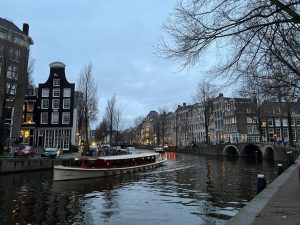
After wandering through the streets for two hours, for which this easily walkable city is tailor made, I stopped at Majestic on Dam Square, an outdoor spot to snack, see, and be seen. A bowl of pea soup with ham, veal/potato croquettes, and a fine cup of hot cocoa filled and warmed me, with room to spare for dinner. Watching passersby beneath the mixed sun and clouds proved mighty entertaining.
*****
Just before dusk on Friday, I rendezvoused in Swissotel’s lobby with Jeremy Hildreth, an American friend I met in 1997. Back then, he lived in Connecticut, where he was deputy to economist Larry Kudlow. We often convened in Manhattan for drinks and libertarian events. Jeremy now advances free-market reforms in London. He hitched the Eurostar across the English Channel to join me for the weekend.
We traversed nearby streets with such jaw-breaking names as Kalfsvelsteeg, Warmoesstraat, and Oudezijds Voorburgwal. The general vibe tonight, and throughout the weekend, was great fun, albeit lower key and with thinner crowds than on my five previous trips. Tragically, last call afflicts most by 4 or 5 a.m. — earlier than before.
Why the comparative quietude? The first week of March is off-season. COVID-19’s toll on tourism lingers. And several merchants complained that Green Party Mayor Femke Halsema has tried to lasso Amsterdam’s anything-goes ethic. She reportedly pushed to remove large neon signs and replace them with smaller displays. The overall effect is less garish but also less zany. I appreciate the former, but I miss the latter.
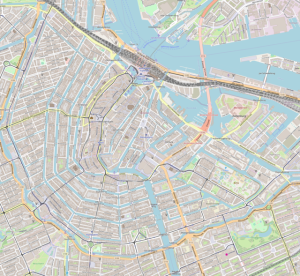
Amsterdam’s streets and canals follow a half-moon pattern that ripples out from Centraal Station. These thoroughfares house dark-brick structures that date back to the early 1600s. Some are so seasoned that they lean like the Tower of Pisa. Nonetheless, they are residences, shops, galleries, and taverns.
The straaten and grachten are interlaced with alleyways, many barely shoulder wide. Strolling aimlessly through this maze is a singular delight. Pleasant surprises arise at every turn. The forks in the road could clog a dishwasher.
Jeremy and I grew hungry and decided to stop somewhere appetizing. We rounded a corner along Wagenstraat and SHAZZAM! There it stood: Ribsfactory Amsterdam!
Located at Amstelstraat 18, Ribsfactory serves delectable slabs of spareribs in five flavors: Garlic, Hot & Spicy, Jack Daniel’s, Smoky Original, and Sweet Honey. We each tried the mixed-rib entrée: three hefty hunks of ribs in three flavors.
Our bar seats yielded instant access to Heineken and other draft beers. This venue spun easygoing rock music at a volume conducive to conversation.
The Dutch devour ribs like Americans gobble chicken wings. Ribsfactory is a first-rate site for indulging this juicy culinary distinction.
Česko-Slovenský Bar/Het Wapen van Londen (Amstel 14) invited us for a nightcap. Its draft beers and decent music were exactly right for this late evening.
Too bad, the bartender ruined everything with Karaoke Night. Even worse, his microphone-wielding, Eastern European, female assistant wasted three straight minutes fruitlessly hounding us to sing.
Nee betekent nee!
No means no!
*****
Saturday evening followed an afternoon devoured by jet lag. Twilight found us on the National Mall–like Museumsplein. At its base sits the Concertgebouw, one of the premier cathedrals in what I call the First Church of Song — the secular faith shared by those of us who board planes and cross oceans to enjoy performances with fellow aficionadi who take our music very, very joyously.
Opened in April 1888, this landmark is understatedly elegant outside and breathtakingly adorned within. Glass-lined Café Viotta offers small meals (soup, sausage, cheese, and bread) and quick service on premises — precisely what one craves before a concert.
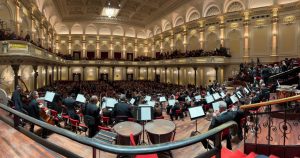
Beneath the Main Hall’s intricately carved ceiling, the equally ornate walls and balcony bear the names of history’s most celebrated symphonic composers. Among them: Cherubini, Dvořák, Mozart, Scarlatti, Schuman, and Strawinsky — spelled in Dutch.
We settled into the front row of the podium seats, immediately behind the orchestra. We were just above the timpanist, close enough to read the composers’ names atop the sheet music. Seated on the aisle, the only way to get closer to the musicians would have been to join the orchestra.
From that location, we savored the music’s full excitement with the added advantage of watching conductor Carlo Rizzi’s expressions — awe, levity, intensity — as he signaled, moment to moment, which tonal colors he sought from his ensemble.
This magnificent experience began with Jörg Widmann’s Con Brio, a 2008 composition written in a “mad hurry” and prescribed as an overture to selections by Ludwig van Beethoven. What Wikipedia calls “an exercise in fury and rhythmic insistence” is an intriguingly cacophonous piece that proudly lacks melody. However, it compensates for this thematic wanderlust with whispers from one section of the orchestra punctuated by outbursts from another.
The violinists aggressively plucked pizzicato style. The bassists responded with sharp, loud bow strokes. After the woodwind artists merely exhaled into their instruments, the brass barked briskly in reply. This piece, unlikely to soothe, was kept fascinating in its ability to startle.
Camille Saint-Saëns’ Cello Concerto No. 1 (1872), a far more traditional work, showcased Germany’s Maximilian Hornung. The incredibly handsome soloist’s tone, energy, and verve propelled this enchanting piece with his Gypsy-esque sound, all answered by the orchestra with waves of aural lushness. French Romantic Saint-Saëns remains among the most satisfying composers. Tonight was no exception.
As this work climaxed, the audience erupted into applause and beckoned Hornung for three curtain calls, after which he encored with the popular Prelude to Johann Sebastian Bach’s Cello Suite No. 1 (circa 1720). During Hornung’s solo, we in the podium seats watched these world-class musicians listen raptly rather than play.
Herr Hornung wrapped it up, hiked past my seat, climbed the aisle, and then returned for an astonishing fourth curtain call.
Intermission included a free drink with each ticket. American concert halls should learn this Dutch lesson.
The program concluded with Beethoven’s Third Symphony (1804). The “Eroica” is, indeed, heroic. Aside from its drift-inducing second movement, its sweeping, majestic sounds graced the ears. Songs within songs wove in and out, most notably a naval march stitched into the fourth movement. Maestro Rizzi led the Nederlands Philharmonisch Orkest across what musicologists consider a key bridge from the Classical to Romantic styles. How fortunate to join this most enriching journey.
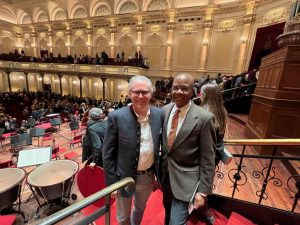
As Los Angeles natives, Jeremy and I both noticed a yellow neon sign en route home. It read Cafe de Klos. It reminded us of KLOS 95.5 FM, Southern California’s Rock Station since 1969. Naturally, we walked through its doors at Kerkstraat 41.
Cafe de Klos has nothing whatsoever to do with KLOS. Instead, klos is a Dutch pun involving both a winch and a slightly profane anagram related to the owner’s setbacks as he founded this eatery.
This humble setting featured a triangular wooden bar, excellent homemade beer (especially De Manke Monnik and Witte Antonia), generous racks of ribs, and an overwhelming serving of lamb chops. I ordered the latter with salad and a baked potato lovingly asphyxiated in butter, sour cream, and chives. This late-night dinner was simple but substantial. The bartender regaled us with stories about this establishment’s artifacts, from a royal insignia on the wall to Dutch historical scenes preserved in stained glass.
Café ’t Gasthuys poured this evening’s nightcaps. This unassuming bar at Grimburgwal 7 offered interesting beers (namely De Eeuwige Jeugd Lellebel), good music, and friendly faces. “Why limit happy to an hour?” its website asks. Precisely.
*****
Sunday afternoon started at the Rijksmuseum, Amsterdam’ flagship fine arts institution and, since 1885, home to Aelbert Cuyp, Frans Hals, and other cornerstones of the Dutch Golden Age.
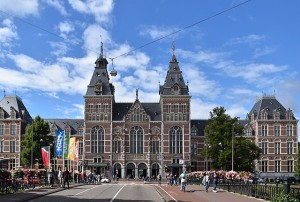
Rembrandt van Rijn’s Night Watch (1642), arguably Holland’s most celebrated painting, now resides inside a high-tech glass cage. At age 381, it’s getting serious work done: Preservationists have stretched it slightly to smooth wrinkles, placed the original canvas atop a fresh cloth base, and repaired cracks and other imperfections. For now, Night Watch hangs naked and unframed as it prepares for the next few centuries on the wall of one of Earth’s premier art museums.
Nearby is another pillar of the Dutch Golden Age.
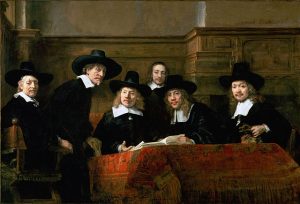
Rembrandt’s The Sampling Officials (1662) depicts draping-industry inspectors checking the quality of dyed textiles. They appear startled and a tad annoyed after we, the viewers, interrupt their important work. As one observer noted, “Rembrandt created a lively group scene by showing us people who are in turn looking at someone else themselves.”
Most Americans will recognize this painting from boxes of Dutch Masters cigars. Nonetheless, encountering the original elicits awe at its sheer beauty and drama across the ages as one imagines apologizing for disturbing these men’s duties.
Elsewhere in the Rijksmuseum, Johannes Vermeer is enjoying his day in the sun. A major retrospective is underway through June 4, with a record 28 of his 34 or 35 known paintings gathered under one roof. Manhattan’s Frick Collection is under renovation. This freed its three Vermeers to fly across the Atlantic for a rare family reunion.
Alas, this exhibit is oversold. Not even my press credentials could gain me access until after my flight home. If this major installation appeals to you, plan your visit far in advance. Spontaneous walk-ins are tough-to-impossible to arrange.
Next, for €3.40 ($3.65), I took the subway from the nearby Vijzelgracht stop back to Rokin station, near Dam Square. Amsterdam’s underground, far below its storied canals, is sleek, swift, and splendidly low on graffiti, garbage, rats, and lunatics. Every U.S. mass-transit executive must study this system.
Two minutes away from Rokin, the Royal Palace awaited. It originally opened as City Hall in 1655, and it looks that way. This otherwise stately building screams for a steam cleaning. It would be totally easy on the eyes but for the shield of unchallenged grime that renders it needlessly dreary.
Inside, however, a self-guided tour reveals sparkling rooms that King Willem-Alexander and the House of Orange-Nassau use for official events. A huge marble wall carving of Atlas carrying a sky-blue globe atop his shoulders dominates the stunning Citizens Hall. This large space is lit with sumptuous chandeliers commissioned by Louis Bonaparte after his brother, Napoleon, installed him as king of Holland — while Paris controlled the Netherlands.
Impressive furniture, paintings, and other objet d’art decorate 17 publicly accessible rooms. These include the Throne Room and the Balcony Chamber, from which the royal family reaches the terrace on which they wave to their subjects.
*****
Sunday night welcomed the weekend’s main event. I built this trip around The Brand New Heavies’ March 5 concert at Paradiso (Weteringschans 6–8), a former church resurrected as a nightclub. Although I first encountered TBNH in the mid-1990s, I had yet to see them live. I impatiently awaited their concert at Manhattan’s unfairly defunct BB King’s nightclub in October 2012. Hurricane Sandy blew those plans away.
TBNH next hit Gotham, just two blocks from my apartment. How convenient!
Too bad I was unaware of that engagement until I discovered TBNH on Webster Hall’s marquee about two hours before showtime. While I ached to go, a pile of work demanded my urgent attention before a transcontinental flight at sunrise. I simply could not pry myself away. So, Amsterdam was where I would lose my Brand New Heavies virginity.
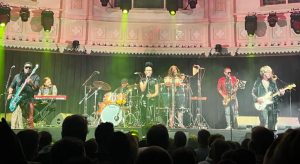
Founded in 1985, TBNH are the Platonic form of a genre that I call Neo-’70s Funk Revival. Others call this Acid Jazz. TBNH’s personnel are the musical nieces and nephews of the Average White Band, James Brown, Chic, Chaka Khan, and Stevie Wonder. Their infinite talent on real instruments stirs the soul. Their refreshingly positive lyrics are the antidote to the venom that poisons too many songs.
A cover of Maria Muldaur’s “Midnight at the Oasis” lit the fireplace, with Angela Ricci’s toasty vocals heating this and subsequent numbers. A steady stream of hits followed: “Sometime,” “Never Stop,” “Brother Sister,” “Dream on, Dreamer,” and much more.
TBNH packed the house. The floor was full, and Heavyheads packed two balconies. Not bad for a Sunday night.
However, perhaps because the sound engineers slowly mastered the mix, the crowd first responded with restraint. I told Jeremy: “The Dutch don’t move much, do they?”
Guitarist and co-founder Simon Bartholomew could have enjoyed a Don Rickles moment by asking the audience: “What is this, the Rijksmuseum? Am I staring at a Rembrandt? Let’s see you Dutchmen dance!”
Sure enough, during “Back to Love,” the mix matched the groove, and cofounder Andrew Levy’s powerful, driving, lead bass lines set heels pounding. The previously tame Dutch, Earth’s tallest people, soon swayed like trees in a gale. Thanks to this incredibly talented ensemble, not least trumpeter Bryan Corbett, the show roared on amid shaking hips, clapping hands, tapping feet, and flying arms.
“Stay This Way” and “Spend Some Time” flowed into “You Are the Universe.” The latter’s inspiring lyrics about hope, opportunity, and personal agency are like chemotherapy against the “You can’t make it due to systemic racism” cancer that left-wing CRT mongers are inflicting on black Americans.
You’re a driver, not a passenger in life
And when you’re ready, you won’t have to try cause
You are the Universe
And there ain’t nothin’ you can’t be
If you conceive it, you can achieve it
That’s why, I believe in you
This song could not be more positive. That’s why watching a black woman sing these words moved me to tears.
TBNH encored with “Forever” and “Dream Come True.” Plentiful audience participation united everyone in warmth, harmony, and the healing power of music.
Above the stage stood evidence of Paradiso’s history as sanctuary. Flowers were frozen in stained glass just beneath the words Soli Deo Gloria — Glory to God Alone. Believers can agree with heathens like me that occasions like these draw the best from our fellow man.
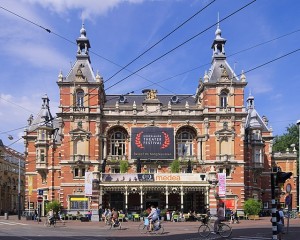
Paradiso is near Leidseplein, an inviting plaza brightened by the shockingly gorgeous Internationaal Theater Amsterdam. This intricate, lovingly lit edifice is a hot-stone massage for the retinas.
Steps away, the former Americana Hotel has reemerged as the Hard Rock Hotel. It boasts a fantastic location, music memorabilia, and Art Deco architecture — a rarity here.
A minute or two away at Leidseplein 11, Satellite Sportscafé’s food was not bad, at least among the few options at about 11:15 p.m. on a Sunday night. The chicken soup was decent, as was the rump steak with baked potato and salad. Jeremy opted for the all-you-can-eat spare ribs, his third rib infusion in as many nights.
Too bad the soundtrack was almost nothing but joyless, angry, sometimes sadistic rap music. What a jarring contrast between this F- and N-bomb-infused sewage versus TBNH’s sunny, smile-fueling sounds from just 20 minutes earlier.
*****
This weekend in Amsterdam was amazingly affordable. The secret is not to pay for airfare and a hotel separately. Rather, buy them together as a package. The economics are incredible:
United Airlines’ round-trip ticket: $1,831. Three nights at Swissotel: $983. Total: $2,814.
Air/hotel package on United’s website: $1,466.
Savings: $1,348 or about 48 percent off.
What a fun, delicious, and enlightening bargain!
Sadly, nothing lasts forever.
*****
Monday at dawn, I stepped out of Swissotel’s sliding glass doors. Dam Square was Damp Square. A drizzle had moistened the paving stones I trod back to Centraal Station. The train whisked me to the plane and then a tranquil, seven-hour flight from Amsterdam to New Amsterdam.
Deroy Murdock is a Manhattan-based Fox News contributor.

